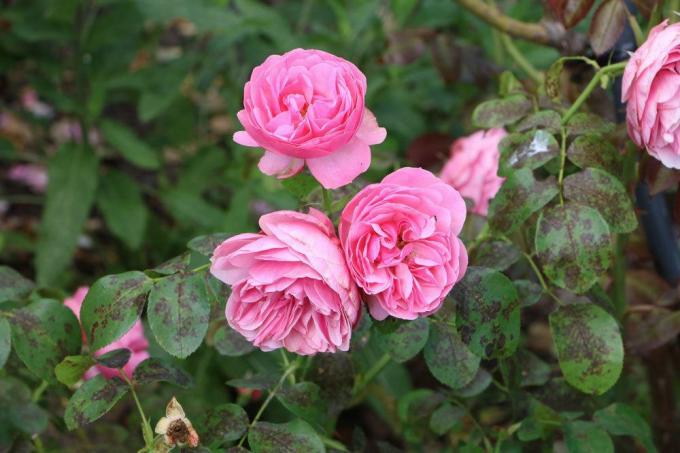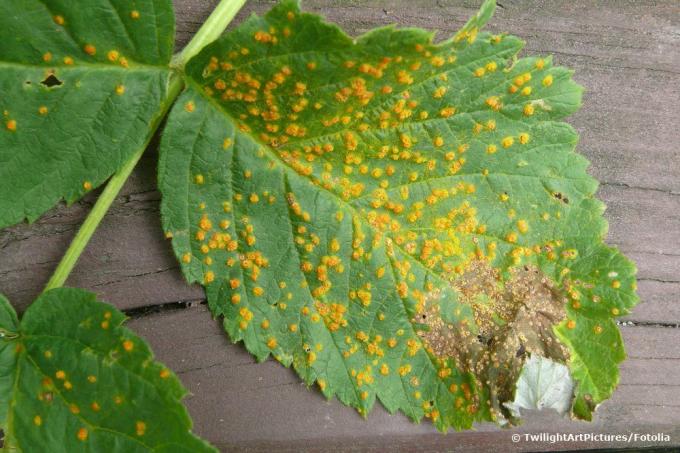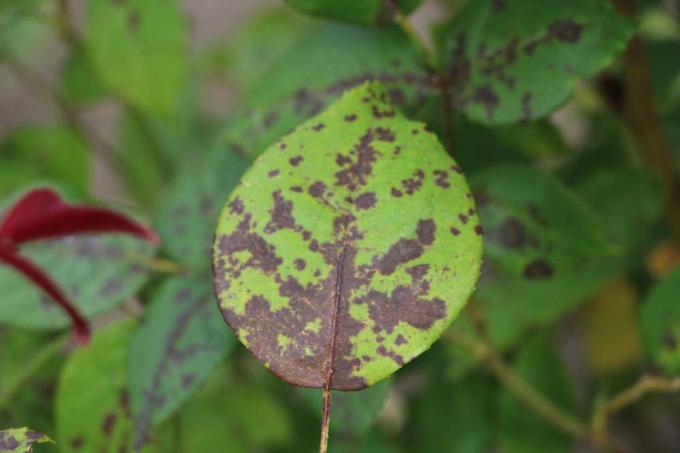
table of contents
- Typical rose diseases
- Soot (Diplocarpon rosae)
- Powdery mildew (Sphaerotheca pannosa var. Pink)
- Rose rust (Phragmidium mucronatum)
- Downy mildew (downy mildew)
- Bark spot disease (Coniothyrium fuckelii Sacc.)
- Common parasites and pests
- Great rose aphid (Macrosiphum rosae)
- Rose wasp
- Rose leaf hoppers (Edwardsiana rosae)
- prevention
Roses used to be considered the flowers of kings. It is not for nothing that they still decorate many a stately ornamental and pleasure garden today. And it is not for nothing that the rose has established itself as one of the ornamental plants par excellence in countless private front and ornamental gardens as an integral part of the summer floral decorations. So that you can enjoy its splendor for as long as possible, the following information will help you with familiar and recurring ones Diseases and damage patterns as an aid to firstly recognizing them and then combating them effectively or even preventing them from the outset avoid.
Typical rose diseases
Although a large number of diseases can occur in individual cases, the majority of the rose cases are affected by one of the following typical rose diseases. It is therefore worthwhile to recognize the associated damage and to be able to eliminate the causer in a targeted manner.
Soot (Diplocarpon rosae)
Symptoms
- different sized, irregular gray-black spots with radially tapering edges
- in the surrounding area, spots mostly yellowish to reddish-yellow discoloration of the rose petals
causes
- host-specific fungus
- usually only affects rose plants
- spreads especially in damp and cool weather
follow
- early leaf shedding in summer in the case of intensive infestation
- Weakening of the entire plant up to the death of young shoots
- thereafter reduced growth in the following year
Combat
- Use of suitable and approved fungicides as soon as they are recognized
Note: Black star soot is the most common among the rose diseases, so it's worth starting from the beginning have suitable fungicides on hand so that they can be used immediately when necessary can.
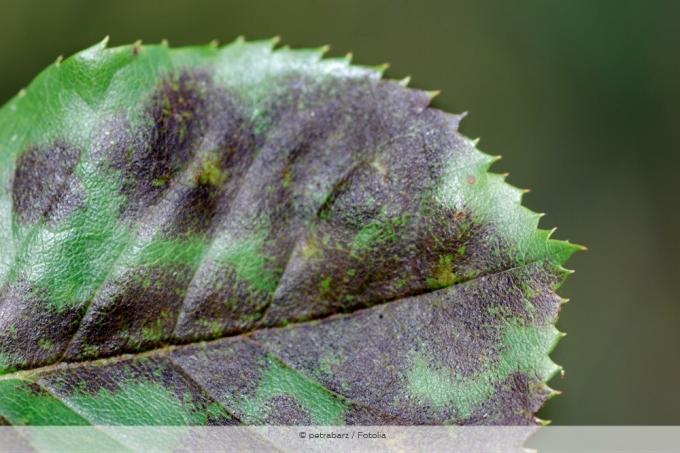
tip: The fungal spores overwinter in the dead leaves on the bed floor. In order to save yourself having to fight again the following year as much as possible, fallen leaves should be removed and disposed of. Composting or mulching the leaves, on the other hand, should be avoided at all costs, as the spores survive these processes without any problems and are even spread further!
Powdery mildew (Sphaerotheca pannosa var. Pink)
Symptoms
- whitish, flour-like coating on leaf tops, but also on flower styles, buds and sepals
- The undersides of the leaves are usually less affected due to less sunlight
causes
- Fungal disease
- So-called "fair weather mushroom", which occurs and spreads mainly in humid and warm weather
- Infestation therefore seldom before June
- occurs mainly on roses that are well cared for, as high growth leads to thick, soft leaves that offer little resistance to the fungal network
follow
- Weakening of the leaves, flowers and the entire plant
- if the infestation is intense, the leaves are shed and the affected areas or the entire rose grow less
Combat
- Use of suitable fungicides
- Prevention is also good with plant strengtheners such as Horsetail broth, or sulfur-containing pesticides possible
tip: In particular, fertilizers with a high nitrogen content lead to an increased susceptibility to powdery mildew. You should therefore only use nitrogen in moderation in order to avoid actually fighting the disease from the outset
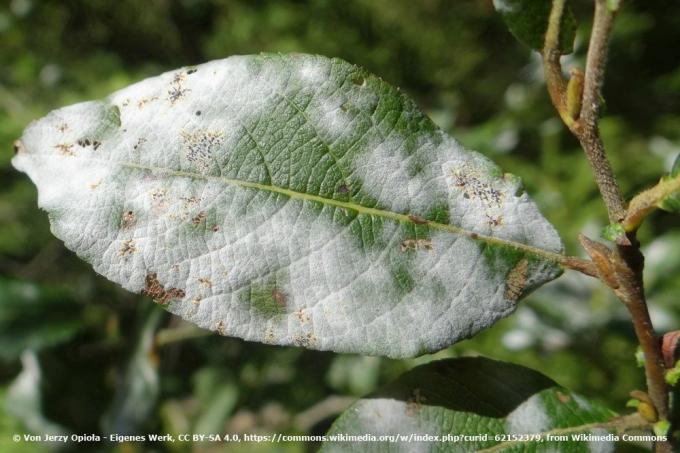
Rose rust (Phragmidium mucronatum)
Symptoms
- On the upper side of the rose's leaf there are numerous orange to rust-red spots with a dark border in some cases, which flow into one another when the infestation is intense
- on the underside of the leaf elongated, on the top of the leaf protruding spore beds in strong red
root cause
- Rust fungus
follow
- leaf shedding in case of severe infestation
- as a result, the shoot and the entire plant are weakened
Combat
- Use of suitable fungicides with approval
- in case of intensive infestation, remove and dispose of infested shoots to prevent spore spread
Downy mildew (downy mildew)
Symptoms
- round, purple spots on the upper side of the leaf
- often converging on expansion
- Often arranged along the leaf center rib
- grayish, mold-like coating on the underside of the leaves in autumn
causes
- Leaf mushrooms
- Occurrence mainly in cool and humid weather conditions due to water droplet infection
follow
- affected leaves fall off
- Weakening of the shoot for the following year
- if the infestation is intense, the whole plant dies
Combat
- Remove and eliminate affected shoots immediately after detection
- Use suitable fungicides to prevent spread
Attention: Although downy mildew is considered to be one of the most aggressive leaf fungi, the range of approved means of control is severely limited. Currently, only a handful of funds are approved for private use and are therefore also available.
Bark spot disease (Coniothyrium fuckelii Sacc.)
Symptoms
- brown to reddish-purple bark spots on trunk and shoots
- mostly originating from shoot buds or injuries to the bark
- later drying out and tearing open of the affected areas
causes
- Fungal disease
- mostly occurring on previous year's shoots
- favored by a high nitrogen fertilization
follow
- The shoots above the infected area die off
Combat
- Cutting off and disposing of the infected shoots
- ideally by incineration or disposal in the residual waste
- in the case of composting or chopping, there is a risk of the spores that cannot be destroyed in this way being passed on

tip: A treatment with fungicides in autumn helps to contain the fungus before the wintering phase and to prevent a rapid outbreak of the infection in spring.
Common parasites and pests
In addition to illnesses, animal guests also find pleasure in a rose that is usually well cared for in the home garden and is growing lush. It is obvious that this does not meet with the approval of the hobby gardener, at least with the following known and repeatedly encountered pests.
Great rose aphid (Macrosiphum rosae)
Identifying features
- approx. Elongated animals 3 to 4 millimeters in size, pale green in color and partly translucent bodies
- found mainly on young shoots, flower buds and leaves
- with intensive infestation in individual cases initially loss of color
- later then curl up and fall off the affected leaves
Damage image
- severe impairment of the infected parts of the plant due to the honeydew excretion of the aphids
follow
- reduced photosynthetic capacity of the leaves
- consequently worse supply situation
- in the case of extreme infestation, parts of leaves or whole leaves dry out and fall off prematurely
Combat
- Use of pesticides
- biological remedy for moderate infestation, for example through Nettle manure or soft soap solution
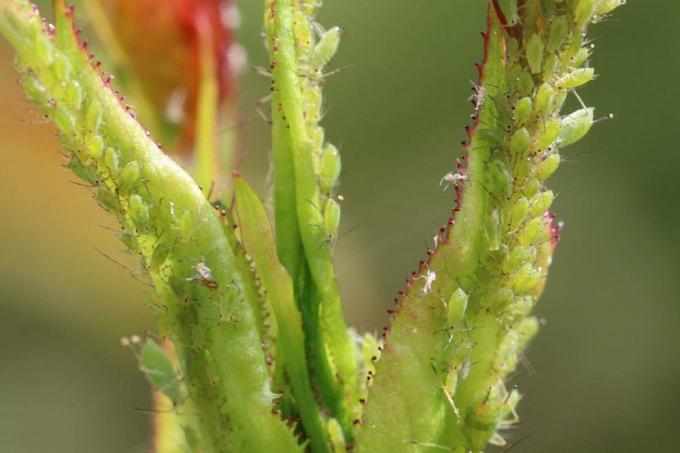
tip: Even small aphid populations can be fought by favoring their natural predators, including the ladybird, ichneumon wasp and lacewing. If the rose is used in the vicinity of host plants or If these animal species have breeding opportunities, the aphid problem is often dealt with from the start without the hobby gardener even paying much attention to it.
Rose wasp
Identifying features
- in the spring eggs are laid on the underside of the leaves
- the most striking feature of an infestation, however, is green-yellowish larvae with a strongly curved abdomen
- Body size up to 10 millimeters
Damage image
- Feeding damage
- Due to so-called window corrosion mostly only leaf skeletons are preserved
- partially covered with remaining, translucent skins on the upper or lower sides of the leaves
follow
- intensive damage to affected shoots
- with severe infestation up to the death of the shoots due to insufficient supply
Combat
- Control after infestation is not possible
- as pesticides are not permitted
- On the other hand, collecting the caterpillars is not effective
- effective protection, however, only by covering the plants with insect protection nets
Rose leaf hoppers (Edwardsiana rosae)
Identifying features
- about 3 millimeters large pest
- easily recognizable by the accumulation of the yellowish-green larvae and the adult animals in groups on the underside of the leaves
- when approaching the plants, the fully-grown animals often jump open easily
Damage image
- small, mostly round, light green bite marks distributed in large numbers over the leaves
follow
- Impairment of the leaf function through to drying out and falling off by sucking out the sap
Combat
- Settlement of predators such as tree and predatory beetles, as well as spiders
- Prevention of overwintering by cutting back young shoots in autumn, since eggs are laid in the cracks in the bark of the young shoots in autumn
prevention
Keep rose diseases out of your own garden from the outset
The selection and effectiveness of chemical agents for eliminating numerous damage patterns is enormous. However, the number of diseases against which there is simply no help is at least as large. Therefore, the breeders of the rose go a different way today, in that more and more new, more and more resistant species are produced. By choosing varieties that are as insensitive as possible, growers and hobby gardeners have the opportunity to avoid numerous diseases from the outset.

